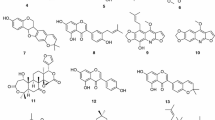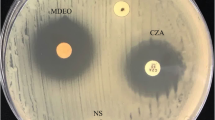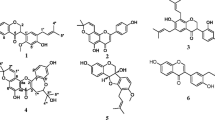Abstract
To evaluate the antibacterial, antibiofilm and antivirulence potential of the main diterpenes from Copaifera spp. oleoresins against multidrug‐resistant (MDR) bacteria. Antimicrobial assays included determination of the Minimum Inhibitory Concentration (MIC), Minimum Bactericidal Concentration (MBC), Minimum Inhibitory Concentration of Biofilm (MICB50), as well as synergistic and antivirulence assays for eight diterpenes against MDR. The tests revealed that two diterpenes (named 1 and 5) showed the best results, with MIC and MBC between 12.5 and 50 μg/mL against most MDR bacteria. These diterpenes exhibited promising MICB50 in concentration between 3.12–25 μg/mL but showed no synergistic antimicrobial activity. In the assessment of antivirulence activity, diterpenes 1 and 5 inhibited only one of the virulence factors evaluated (Dnase) produced by some strains of S. aureus at subinhibitory concentration (6.25 μg/mL). Results obtained indicated that diterpenes isolated from Copaifera oleoresin plays an important part in the search of new antibacterial and antibiofilm agents that can act against MDR bacteria.

Similar content being viewed by others
Data availability
No datasets were generated or analysed during the current study.
References
Abrão F, Araújo Costa LD, Alves JM, Senedese JM, Castro PT, Ambrósio SR, Veneziani RC et al (2015) Copaifera langsdorffii oleoresin and its isolated compounds: antibacterial effect and antiproliferative activity in cancer cell lines. BMC Complement Altern Med 15:443. https://doi.org/10.1186/s12906-015-0961-4
Abrão F, Silva TS, Moura CL, Ambrósio SR, Veneziani RCS, de Paiva REF, Bastos JK, Martins CHG (2021) Oleoresins and naturally occurring compounds of Copaifera genus as antibacterial and antivirulence agents against periodontal pathogens. Sci Rep 11:4953. https://doi.org/10.1038/s41598-021-84480-7
Abrao F, Alves JA, Andrade G, De Oliveira PF, Ambrósio SR, Veneziani RCS, Tavares DC, Bastos JK et al (2018) Antibacterial effect of Copaifera duckei Dwyer oleoresin and its main diterpenes against oral pathogens and their cytotoxic effect. Front Microbiol 9:201. https://doi.org/10.3389/fmicb.2018.00201
Alves FRF, Silva MG, Rôças IN, Siqueira Júnior JF (2013) Biofilm biomass disruption by natural substances with potential for endodontic use. Braz Oral Res 27:20–25. https://doi.org/10.1590/S1806-83242013000100004
Alves JM, Senedese JM, Leandro LF, Castro PT, Pereira DE, Carneiro LJ, Ambrósio SR, Bastos JK et al (2017) Copaifera multijuga oleoresin and its constituent diterpene (−)-copalic acid: Genotoxicity and chemoprevention study. Mutat Res 819:26–30. https://doi.org/10.1016/j.mrgentox.2017.05.001
Andrade BB, Moreira MR, Ambrosio SR, Furtado NAJC, Cunha WR, Martins CHG, Veneziani RCS (2011) Evaluation of ent-kaurenoic acid derivatives for their anticariogenic activity. Nat Prod Commun 6:777–780. https://doi.org/10.1177/1934578X1100600608
Arruda C, Aldana Mejía JA, Ribeiro VP, Gambeta Borges CH, Gomes Martins CH, Sola Veneziani RC, Ambrósio SR, Bastos JK (2019) Occurrence, chemical composition, biological activities and analytical methods on Copaifera genus- a review. Biomed Pharmacother 109:1–20. https://doi.org/10.1016/j.biopha.2018.10.030
Barbosa ALP, Wenzel-Storjohann A, Barbosa JD, Zidorn C, Peifer C, Tasdemir D, Cicek SS (2019) Antimicrobial and cytotoxic effects of the Copaifera reticulata oleoresin and its main diterpene acids. J Ethnopharmacol 233:94–100. https://doi.org/10.1016/j.jep.2018.11.029
Borges CH, Cruz MG, Carneiro LJ, da Silva JJ, Bastos JK, Tavares DC, De Oliveira PF, Rodrigues V et al (2016) Copaifera duckei oleoresin and its main nonvolatile Terpenes: in vitro Schistosomicidal properties. Chem Biodivers 13:1348–1356. https://doi.org/10.1002/cbdv.201600065
Carneiro LJ, Bianchi TC, da Silva JJM, Oliveira LC, Borges CHG, Lemes DC, Bastos JK, Veneziani RCS, Ambrosio SR (2018) Development and validation of a rapid and reliable RP-HPLC-PDA method for the quantification of six diterpenes in Copaifera duckei, Copaifera reticulata and Copaifera multijuga oleoresins. J Brazil Chem Soc 29:729–737. https://doi.org/10.21577/0103-5053.20170195
Carneiro LJ, Tasso TO, Santos MFC, Goulart MO, dos Santos R, Bastos JK, da Silva JJM, Crotti AEM, Parreira RLT, Orenha RP, Veneziani RCS, Ambrosio SR (2020) Copaifera multijuga, Copaifera pubiflora and Copaifera trapezifolia oleoresins: chemical characterization and in vitro cytotoxic potential against tumoral cell lines. J Brazil Chem Soc 31:1679–1689. https://doi.org/10.21577/0103-5053.20200054
Cascioferro S, Carbone D, Parrino B, Pecoraro C, Giovannetti E, Cirrincione G, Diana P (2020) Therapeutic strategies to counteract antibiotic resistance in MRSA biofilm-associated infections. Chem Med Chem 16:65–80. https://doi.org/10.1002/cmdc.202000677
Chandki R, Banthia P, Banthia R (2011) Biofilms: a microbial home. J Indian Soc Periodontol 15:e111–e114. https://doi.org/10.4103/0972-124X.84377
Chaturvedi V, Ramani R, Ghannoum MA, Killian SB, Holliday N, Knapp C, Ostrosky-Zeichner L, Messer SA et al (2008) Multilaboratory testing of antifungal combinations against a quality control isolate of Candida krusei. Antimicrob Agents Chemother 52:e1500–e1502. https://doi.org/10.1128/AAC.00574-07
Clinical and Laboratory Standards Institute (CLSI) (2009) Methods for dilution antimicrobial susceptibility tests for bacteria that grow aerobically. Approved Standard 8th edn. Clinical and Laboratory Standards Institute, Wayne. CLSI publication M7-A8
Clinical and Laboratory Standards Institute (CLSI) (2012) Methods for dilution antimicrobial susceptibility tests for bacteria that grow aerobically. Approved standard, 9th edn. Clinical and Laboratory Standards Institute, Wayne. CLSI publication M7-A9
Da Trindade R, da Silva J, Setzer W (2018) Copaifera of the Neotropics: a review of the phytochemistry and pharmacology. Int J Mol Sci 19:1511. https://doi.org/10.3390/ijms19051511
Donlan RM, Costerton JW (2002) Biofilms: survival mechanisms of clinically relevant microorganisms. Clin Microbiol Rev 15:e167–e193. https://doi.org/10.1128/CMR.15.2.167-193.2002
Du W, Chen H, Xiao S, Tang W, Shi G (2017) New insight on antimicrobial therapy adjustment strategies for Gram-negative bacterial infection. A cohort study. Medicine 96:e6439. https://doi.org/10.1097/MD.0000000000006439
Furtado RA, de Oliveira PF, Senedese JM, Ozelin SD, de Souza LDR, Leandro LF, de Oliveira WL, da Silva JJM et al (2018) Assessment of genotoxic activity of oleoresins and leaves extracts of six Copaifera species for prediction of potential human risks. J Ethnopharmacol 221:119–125. https://doi.org/10.1016/j.jep.2018.04.002
Inui T, Wang Y, Deng S, Smith DC, Franzblau SG, Pauli GF (2007) Counter-current chromatography based analysis of synergy in an anti-tuberculosis ethnobotanical. J Chromatogr A 1151:e211–e215. https://doi.org/10.1016/j.chroma.2007.01.127
Jeong SI, Kim BS, Keum KS, Lee KH, Kang SY, Park BI, Lee YR, You YO (2013) Kaurenoic acid from Aralia continentalis inhibits biofilm formation of Streptococcus mutans. Evid Based Complement Alternat Med 2013:160592. https://doi.org/10.1155/2013/160592
Karygianni L, Ren Z, Koo H, Thurnheer T (2020) Biofilm matrixome: extracellular components in structured microbial communities. Trends Microbiol 28:668–681. https://doi.org/10.1016/j.tim.2020.03.016
Kian D, Lancheros CAC, Assolini JP, Arakawa NS, Veiga-Júnior VF, Nakamura CV, Pinge-Filho P, Conchon-Costa I et al (2018) Trypanocidal activity of copaiba oil and kaurenoic acid does not depend on macrophage killing machinery. Biomed Pharmacother 103:1294–1301. https://doi.org/10.1016/j.biopha.2018.04.164
Kuete V, Wabo GF, Ngameni B, Mbaveng AT, Metuno R, Etoa FX, Ngadjui BT, Benga VP et al (2007) Antimicrobial activity of the methanolic extract, fractions and compounds from the stem bark of Irvingia gabonensis (Ixonanthaceae). J Ethnopharmacol 114:54–60. https://doi.org/10.1016/j.jep.2007.07.025
Kugimiya W, Otani Y, Hashimoto Y, Takagi Y (1986) Molecular cloning and nucleotide sequence of the lipase gene from Pseudomonas fragi. Biochem Biophys Res Commun 141:185–190. https://doi.org/10.1016/s0006-291x(86)80352-7
Leandro LM, de Sousa Vargas F, Barbosa PC, Neves JK, da Silva JA, da Veiga-Junior VF (2012) Chemistry and biological activities of terpenoids from copaiba (Copaifera spp.) oleoresins. Molecules 17:3866–89. https://doi.org/10.3390/molecules17043866
Lewis RE, Diekema DJ, Messer AS, Pfaller MA, Klepser ME (2002) Comparison of Etest, chequerboard dilution and time-kill studies for the detection of synergy or antagonism between antifungal agents tested against Candida species. J Antimicrob Chemother 49:345–351. https://doi.org/10.1093/jac/49.2.345
Li X, Sun L, Zhang P, Wangm Y (2021) Novel Approaches to combat medical device-associated biofilms. Coatings 11:294. https://doi.org/10.3390/coatings11030294
Lozano C, Torres C (2017) Update on antibiotic resistance in Gram positives. Enferm Infecc Microbiol Clin 35:2–8. https://doi.org/10.1016/S0213-005X(17)30028-9
Monecke S, Coombs G, Shore AC, Coleman DC, Akpaka P et al (2011) A field guide to pandemic, epidemic and sporadic clones of methicillin-resistant Staphylococcus aureus. PLoS ONE 6:e17936. https://doi.org/10.1371/journal.pone.0017936
Moraes TDS, Leandro LF, Santiago MB, Silva LDO, Bianchi TC, Veneziani RCS, Ambrósio SR, Ramos SB et al (2020) Assessment of the antibacterial, antivirulence, and action mechanism of Copaifera pubiflora oleoresin and isolated compounds against oral bacteria. Biomed Pharmacother 129:110467. https://doi.org/10.1016/j.biopha.2020.110467
Moreira MR, Souza AB, Soares S, Bianchi TC, Eugênio DS, Lemes DC, Martins CHG, Moraes TS et al (2016) ent-Kaurenoic acid-rich extract from Mikania glomerata: in vitro activity against bacteria responsible for dental caries. Fitoterapia 112:211. https://doi.org/10.1016/j.fitote.2016.06.007
Moreti DLC, Leandro LF, da Silva MT, Moreira MR, Sola Veneziani RC, Ambrosio SR, Gomes BP, Martins CHG (2017) Mikania glomerata Sprengel extract and its major compound ent-kaurenoic acid display activity against bacteria present in endodontic infections. Anaerobe 47:201–208. https://doi.org/10.1016/j.anaerobe.2017.06.008
Nicolas I, Bordeau V, Bondon A, Baudy-Floc’h M, Felden B (2019) Novel antibiotics effective against gram-positive and -negative multiresistant bacteria with limited resistance. PLoS Biol 17:e3000337. https://doi.org/10.1371/journal.pbio.3000337
Nostro A, Bisignano G, Cannatelli MA, Crisafi G, Germanò MP, Alonzo V (2001) Effects of Helichrysum italicum extract on growth and enzymatic activity of Staphylococcus aureus. Int J Antimicrob Agents 17:517–520. https://doi.org/10.1016/s0924-8579(01)00336-3
O’Neill J (2014) The Review on antimicrobial resistance, chaired by Jim O’Neill. Antimicrobial resistance: tackling a crisis for the health and wealth of nations. Available in: https://wellcomecollection.org/works/rdpck35v. Accessed 04/07/2024
Otto M (2009) Staphylococcus epidermidis - the “accidental” pathogen. Nat Rev Microbiol 7:555–567. https://doi.org/10.1038/nrmicro2182
Richards JJ, Melander C (2009) Controlling bacterial biofilms. Chem Biochem 10:e2287–e2294. https://doi.org/10.1002/cbic.200900317
Sarker SD, Nahar L, Kumarasamy Y (2007) Microtitre plate-based antibacterial assay incorporating resazurin as an indicator of cell growth, and its application in the in vitro antibacterial screening of phytochemicals. Methods 42:321–324. https://doi.org/10.1016/j.ymeth.2007.01.006
Scribel LV, Silva-Carvalho MC, Souza RR, Superti SV, Kvitko CH, Figueiredo AM, Zavascki AP (2009) Clinical and molecular epidemiology of methicillin-resistant Staphylococcus aureus carrying SCCmecIV in a university hospital in Porto Alegre, Brazil. Diagn Microbiol Infect Dis 65:457–461. https://doi.org/10.1016/j.diagmicrobio.2009.08.012
Sharma D, Misba L, Khan AU (2019) Antibiotics versus biofilm: an emerging battleground in microbial communities. Antimicrob Resist Infect Control 8:76. https://doi.org/10.1186/s13756-019-0533-3
Silva TS, Silva JMB, Braun GH, Mejia JAA, Ccapatinta GVC, Santos MFC, Tanimoto MH, Bastos JK et al (2021) Green and Red Brazilian Propolis: antimicrobial potential and antivirulence against ATCC and clinically isolated multidrug-resistant bacteria. Chem Biodivers 18:e2100307. https://doi.org/10.1002/cbdv.202100307
Simao MR, Carneiro LJ, dos Santos RA, Bastos JK, Veneziani RCS, Ambrosio SR, Mizuno CS (2016) In vitro cytotoxicity study of ent-kaurenoic acid derivatives against human breast carcinoma cell line. Med Chem Res 25:303–309. https://doi.org/10.1007/s00044-015-1483-9
Souza AB, Martins CHG, Souza MGM, Furtado NAJC, Heleno VCG, Sousa JPB, Rocha EMP, Bastos JK et al (2011a) Antimicrobial activity of terpenoids from Copaifera langsdorffii Desf. against cariogenic bacteria. Phytother Res 25:215–20. https://doi.org/10.1002/ptr.3244
Souza AB, Souza MGM, Moreira MA, Moreira MR, Furtado NAJC, Martins CHG, Bastos JK, Santos RA et al (2011b) Antimicrobial evaluation of diterpenes from Copaifera langsdorffii oleoresin against periodontal anaerobic bacteria. Molecules 16:9611–9619. https://doi.org/10.3390/molecules16119611
Souza MGM, Leandro LF, Moraes TDS, Abrão F, Veneziani RCS, Ambrosio SR, Martins CHG (2018) ent-Copalic acid antibacterial and anti-biofilm properties against Actinomyces naeslundii and Peptostreptococcus anaerobius. Anaerobe 52:43–49. https://doi.org/10.1016/j.anaerobe.2018.05.013
Sun Y, Ye J, Hou Y, Chen H, Cao J, Zhou T (2017) Predation efficacy of Bdellovibrio bacteriovorus on multidrug-resistant clinical pathogens and their corresponding biofilms. Jpn J Infect Dis 70:485–489. https://doi.org/10.7883/yoken.JJID.2016.405
Tam K, Torres VJ (2019) Staphylococcus aureus secreted toxins and extracellular enzymes. Microbiol Spectr 7:2. https://doi.org/10.1128/microbiolspec.GPP3-0039-2018
Tincusi BM, Jiménez IA, Bazzocchi IL, Moujir LM, Mamani ZA, Barroso JP, Ravelo AG, Hernández BV (2002) Antimicrobial terpenoids from the oleoresin of the Peruvian medicinal plant Copaifera paupera. Planta Med 68:808–812. https://doi.org/10.1055/s-2002-34399
Uddin TM, Chakraborty AJ, Khusro A, Zidan BRM, Mitra S, Emran TB, Dhama K, Ripon MKH, Gajdács M, Sahibzada MUK, Hossain MJ, Koirala N (2021) Antibiotic resistance in microbes: History, mechanisms, therapeutic strategies and future prospects. J Infect Public Health 14(12):1750–1766. https://doi.org/10.1016/j.jiph.2021.10.020
Urzúa A, Rezende MC, Mascayano C, Vasquez LA (2008) Structure-activity study of antibacterial diterpenoids. Molecules 13:882–891. https://doi.org/10.3390/molecules13040822
Vivas R, Barbosa AAT, Dolabela SS, Jain S (2019) Multidrug-resistant bacteria and alternative methods to control them: an overview. Microb Drug Resist 25:890–908. https://doi.org/10.1089/mdr.2018.0319
Wei GX, Campagna AN, Bobek LA (2006) Effect of MUC7 peptides on the growth of bacteria and on Streptococcus mutans biofilm. J Antimicrob Chemother 57:1100–1109. https://doi.org/10.1093/jac/dkl120
Xue L, Chen YY, Yan Z, Lu W, Wan D, Zhu H (2019) Staphyloxanthin: a potential target for antivirulence therapy. Infect Drug Resist 12:2151–2160. https://doi.org/10.2147/IDR.S193649
Zhang L, Mah TF (2008) Involvement of a novel efflux system in biofilm-specific resistance to antibiotics. J Bacteriol 190:e4447–e4452. https://doi.org/10.1128/JB.01655-07
Funding
This work was supported by the São Paulo Research Foundation (FAPESP, grants numbers 2011/13630-7 and 2012/25237-0). The authors are grateful to the National Council for Scientific and Technological Development (CNPq, grants number 307387/2016-0, for the granted fellowships) and Coordination for the Improvement of Higher Education Personnel (CAPES, code 001).
Author information
Authors and Affiliations
Contributions
LFL, TSM, and MBS conducted the experiments. RCSV, SRA, JKB, and CHGM contributed the reagents, materials, and analytical tools, and analyzed and interpreted the data. LFL and JLD wrote the paper. TSM, MBS, RSP, and CHGM conceived the study and established the study design. JLD, RCSV, SRA, JKB, RSP, and CHGM performed critical revision of the final version of the article. The authors declare that all data were generated in-house and that no paper mill was used.
Corresponding author
Ethics declarations
Ethics approval
Not applicable.
Consent to participate
Not applicable.
Consent for publication
Not applicable.
Competing interests
The authors declare no competing interests.
Additional information
Publisher's Note
Springer Nature remains neutral with regard to jurisdictional claims in published maps and institutional affiliations.
Rights and permissions
Springer Nature or its licensor (e.g. a society or other partner) holds exclusive rights to this article under a publishing agreement with the author(s) or other rightsholder(s); author self-archiving of the accepted manuscript version of this article is solely governed by the terms of such publishing agreement and applicable law.
About this article
Cite this article
Leandro, L.F., Moraes, T.S., Damasceno, J.L. et al. Antibacterial, antibiofilm, and antivirulence potential of the main diterpenes from Copaifera spp. oleoresins against multidrug‐resistant bacteria. Naunyn-Schmiedeberg's Arch Pharmacol (2024). https://doi.org/10.1007/s00210-024-03077-9
Received:
Accepted:
Published:
DOI: https://doi.org/10.1007/s00210-024-03077-9




